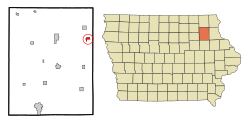Elgin, Iowa
| Elgin, Iowa | |
|---|---|
| City | |
| Nickname(s): The Little Switzerland of Iowa | |
 Location of Elgin, Iowa |
|
| Coordinates: 42°57′21″N 91°38′11″W / 42.95583°N 91.63639°WCoordinates: 42°57′21″N 91°38′11″W / 42.95583°N 91.63639°W | |
| Country |
|
| State |
|
| County | Fayette |
| Area | |
| • Total | 0.66 sq mi (1.71 km2) |
| • Land | 0.66 sq mi (1.71 km2) |
| • Water | 0 sq mi (0 km2) |
| Elevation | 807 ft (246 m) |
| Population (2010) | |
| • Total | 683 |
| • Estimate (2016) | 644 |
| • Density | 1,035/sq mi (399.5/km2) |
| Time zone | Central (CST) (UTC-6) |
| • Summer (DST) | CDT (UTC-5) |
| ZIP code | 52141 |
| Area code(s) | 563 |
| FIPS code | 19-24645 |
| GNIS feature ID | 0456274 |
Elgin is a city in Fayette County, Iowa, United States. The population was 683 at the 2010 census.
Elgin is located at 42°57′21″N 91°38′11″W / 42.95583°N 91.63639°W (42.955965, -91.636394) at the confluence of Otter Creek with the Turkey River. According to the United States Census Bureau, the city has a total area of 0.66 square miles (1.71 km2), all of it land.
Elgin and the neighboring towns of Clermont and Wadena made up the Valley Community School district. Due to diminishing class sizes and less aid from the state of Iowa, Valley combined services in 2013 with the nearby North Fayette School district which comprises the towns of West Union, Hawkeye and Fayette and the combined district is now called North Fayette Valley, with the middle school being in Elgin and the high school located in West Union. The school's mascot is now called the Tigerhawks (from a combination of the two schools' mascots, the Tigers and the Hawks, respectively). This sharing program will last until the 2015-2016 school year.
As of the census of 2010, there were 683 people, 318 households, and 191 families residing in the city. The population density was 1,034.8 inhabitants per square mile (399.5/km2). There were 343 housing units at an average density of 519.7 per square mile (200.7/km2). The racial makeup of the city was 98.8% White, 0.1% African American, 0.4% Native American, 0.1% from other races, and 0.4% from two or more races. Hispanic or Latino of any race were 1.0% of the population.
...
Wikipedia
